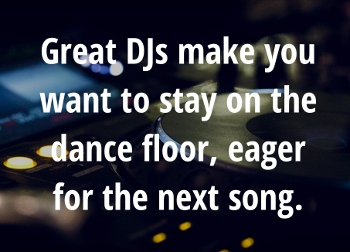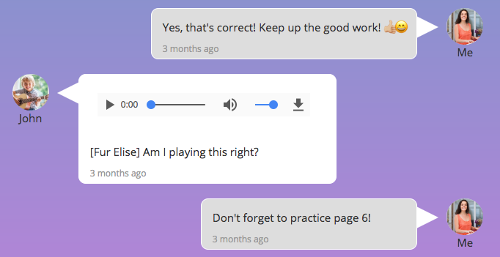Help! I'm Not a Good Motivator
My music students aren’t motivated. How can I get them to be?
Well, instead of looking to build their motivation, why don’t we look at it in terms of energy? Motivation is really linked to how much energy and momentum the student is feeling. If a student just aced a song and they’re really proud of it, their energy levels are up. It’s the perfect time to keep the momentum up and throw something a little bit more challenging at them. Sometimes, a student’s energy levels are low - maybe from being stuck on a challenging topic or not doing well at the last recital.
When energy is low, you should focus more on getting that back up first and foremost. If a student’s energy/motivation levels are low, no matter what you teach, they won’t learn it as well as they should. They most likely won’t absorb everything and practice little. If you focus on getting their energy and interest up, they will take it upon themselves to improve and really hear what you’re teaching them.
 Think: DJs and stand up comedians. They always have to be reading their audience’s energy levels to keep their interest. If the crowd is finally getting lively at a party, the DJ shouldn’t suddenly cut to slow songs. On the other hand, if the crowd has been dancing hard all night and you see a lot of them exiting the floor, maybe it’s time for a more chill vibe. Like this, teachers should be reading their student’s energy levels in order to work with them (as much as is reasonable) and keep the student’s interest and motivation up.
Think: DJs and stand up comedians. They always have to be reading their audience’s energy levels to keep their interest. If the crowd is finally getting lively at a party, the DJ shouldn’t suddenly cut to slow songs. On the other hand, if the crowd has been dancing hard all night and you see a lot of them exiting the floor, maybe it’s time for a more chill vibe. Like this, teachers should be reading their student’s energy levels in order to work with them (as much as is reasonable) and keep the student’s interest and motivation up.
So, how do we build and maintain students’ energy levels?
Build Energy
It’s obvious, but needs to be said: avoid energy-killers at the beginning of a lesson or piece. Comedians don’t start off with a risky joke. They want to get the crowd warmed up, relaxed, laughing first - all of which ensures better reception of the risky joke later on. In the lesson world, I guess my point is to not throw out an assignment too challenging too soon. Of course, maybe you have students who are motivated by challenges, in which case it’s fine. But many students find it hard to practice or stay interested in a topic they can’t quite wrap their head around. Not without warming up to it.
Building energy happens incrementally, like getting a ball rolling. Sometimes all the student needs to warm up to a task is a couple of easy tasks before it. Examples of these are concept games, simple tasks/assignments, or even showing how professionals also struggle with learning things (you can use yourself!). Once you have the student feeling like “I can do this!”, they will be more likely to take on the challenge with enthusiasm.
Maintaining Energy
Once you’ve got the ball rolling, you want to keep it rolling for as long as possible. It’s inevitable that at some point it might plateau again, but at that point, you’d focus on building energy again. The most basic way energy is gauged is through you, the teacher! If you’re energetic, excited, and passionate about what you’re teaching, the student will feel it too. It’s contagious.
 Timing is everything when it comes to maintaining energy. DJs start out light and then incrementally pump up the energy to where they want the crowd to be. If you’ve ever had a great DJ, you know you can’t help but follow the songs one after another. They make you want to stay on the dance floor, eager for the next song. Like this, if you keep students’ energy levels up, they will want to learn more and be eager for the next challenge.
Timing is everything when it comes to maintaining energy. DJs start out light and then incrementally pump up the energy to where they want the crowd to be. If you’ve ever had a great DJ, you know you can’t help but follow the songs one after another. They make you want to stay on the dance floor, eager for the next song. Like this, if you keep students’ energy levels up, they will want to learn more and be eager for the next challenge.
You also have to know when to take away energy. Students can easily burn out, especially in the early stages. This can result in boredom, frustration, and just overall lack of interest in lessons. If you see this happening, make sure to switch your focus to bringing the energy level back up to keep students from detaching completely. Comedians know when they can keep a joke going, and they know when the joke is over - and they gracefully segue into a new topic to keep the energy alive.
Although it’s important to keep up the energy in lessons, it’s even more important to maintain it when they’re at home, practicing. Practice is where all the improvement is supposed to happen - but students are usually detached from their teachers, alone, and sort of left to do it all on their own, 6 days of the week. Thankfully, in this modern age, there are tools to make practice easy and connected. Take Better Practice for example (you didn’t see this coming, did you?): it was made specifically to keep energy levels up during practice (where students all too often hit a mental wall).
 Students can send each other little encouragements throughout the week, while teachers can send any personal reminders or answer students’ questions directly through a chat. Teachers can also easily make little check-up assignments due midweek, like sending a recording or answers through the app.
Students can send each other little encouragements throughout the week, while teachers can send any personal reminders or answer students’ questions directly through a chat. Teachers can also easily make little check-up assignments due midweek, like sending a recording or answers through the app.
It’s also easy to change course midweek if you see the student is struggling (or if the student lets you know through the chat). If you see their practice quality dropping and they’re uninterested, maybe add a fun assignment or change the requirements. Anything you change will immediately be reflected on their end as well, so you don’t have to waste a week of them banging their head on a wall until the next lesson. On the other hand, if a student is flying through their assignments, you can ride that wave of energy and add a couple more right from home! Either way, you are gauging the student’s energy levels and helping to make the most of their practice week.
 Better Practice Blog
Better Practice Blog